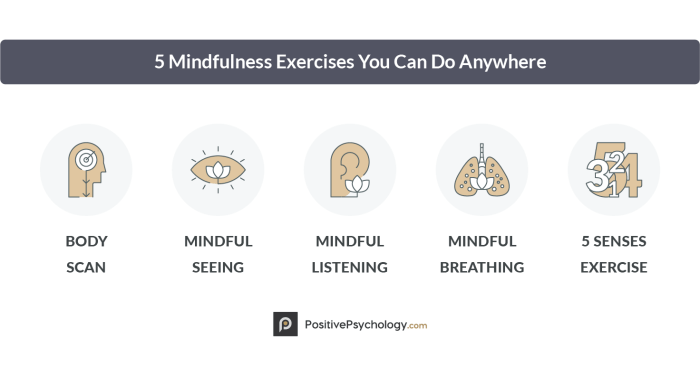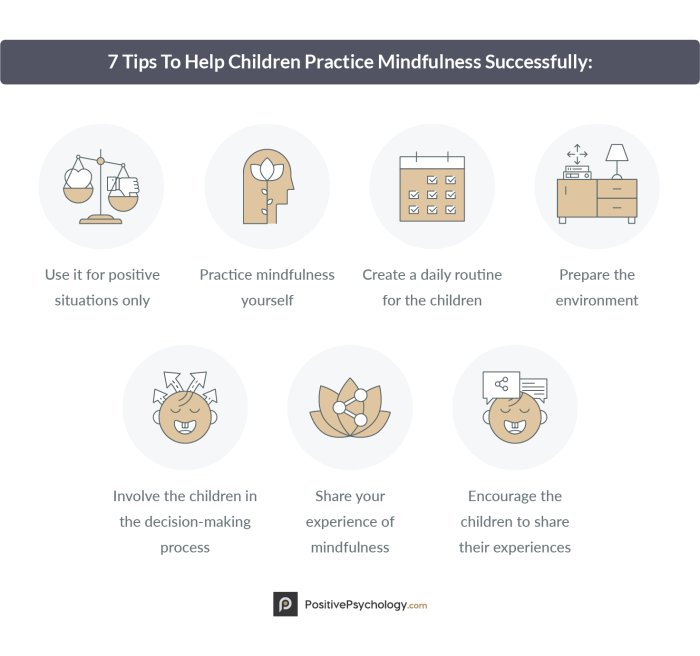Mindfulness Exercises offer a path to inner peace and clarity. Dive into the world of mindfulness with a hip twist, exploring various techniques and their benefits for a balanced lifestyle.
From breathing exercises to mindful walking, discover how these practices can revolutionize your daily routine and uplift your overall well-being.
Introduction to Mindfulness Exercises
Mindfulness exercises are practices that help individuals focus on the present moment and increase self-awareness. These exercises are beneficial for reducing stress, improving mental clarity, and enhancing overall well-being.
The origins of mindfulness exercises can be traced back to ancient Buddhist meditation practices. Over time, these exercises have evolved and are now widely used in various secular settings such as schools, workplaces, and healthcare facilities.
Popular Mindfulness Exercises
- Body Scan Meditation: This exercise involves focusing on different parts of the body, noticing any sensations without judgment.
- Deep Breathing: A simple yet effective exercise that involves taking slow, deep breaths to calm the mind and body.
- Walking Meditation: Practiced in silence, this exercise involves paying attention to each step and the surrounding environment while walking slowly.
- Loving-Kindness Meditation: This exercise focuses on cultivating feelings of compassion and kindness towards oneself and others.
Types of Mindfulness Exercises

Mindfulness exercises come in various forms, each with its own unique focus and benefits. These exercises are designed to help individuals increase self-awareness, reduce stress, and improve overall well-being.
Breathing Techniques
Breathing techniques are a common form of mindfulness exercise that involves focusing on the breath. This can include deep breathing, diaphragmatic breathing, or simply observing the breath without trying to control it. By focusing on the breath, individuals can bring their attention to the present moment and calm the mind.
Body Scans, Mindfulness Exercises
Body scans are another type of mindfulness exercise that involves bringing attention to different parts of the body. This can help individuals tune into physical sensations, release tension, and cultivate a sense of relaxation. By scanning the body from head to toe, individuals can become more aware of any areas of discomfort or tightness.
Mindful Walking
Mindful walking is a form of meditation that involves walking slowly and deliberately while focusing on each step. This exercise can be done indoors or outdoors and allows individuals to connect with their surroundings while staying present in the moment. Mindful walking can help improve concentration, reduce anxiety, and increase overall mindfulness.
Benefits of Mindfulness Exercises
Mindfulness exercises offer a wide array of benefits that can significantly improve both mental and physical well-being. By incorporating these practices into daily routines, individuals can experience a positive impact on various aspects of their health.
Mental Health Benefits
- Reduction in stress and anxiety levels:
- Improved focus and concentration:
- Enhanced emotional regulation:
Physical Health Benefits
- Lower blood pressure:
- Improved sleep quality:
- Boosted immune system:
Personal Success Stories
“After implementing mindfulness exercises into my daily routine, I noticed a significant decrease in my stress levels and a newfound sense of calmness.”
“Practicing mindfulness regularly not only helped me sleep better but also improved my overall mood and outlook on life.”
Mindfulness Exercises for Different Settings

Incorporating mindfulness exercises into various settings like the workplace, schools, or home can help individuals manage stress and improve focus.
Workplace
- Take a few minutes to practice deep breathing exercises at your desk to reduce stress levels.
- Practice mindful walking during breaks to clear your mind and improve productivity.
- Use mindfulness apps or guided exercises to help you stay focused and present during work tasks.
Schools
- Start the day with a short mindfulness exercise to help students transition into a focused state for learning.
- Incorporate mindful breathing techniques during test-taking or stressful situations to calm nerves.
- Encourage students to practice gratitude exercises to promote a positive mindset and reduce anxiety.
Home
- Begin or end the day with a family mindfulness practice to promote connection and relaxation.
- Practice mindful eating by savoring each bite and paying attention to the flavors and textures of food.
- Create a quiet space at home for meditation or reflection to unwind and de-stress after a busy day.







